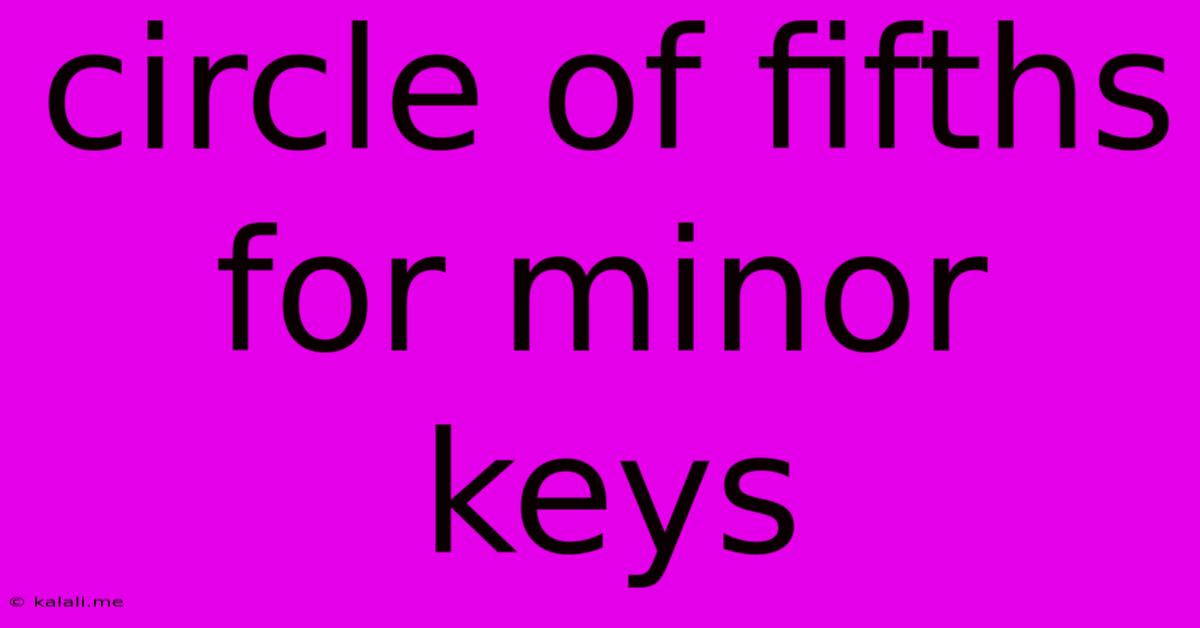Circle Of Fifths For Minor Keys
Kalali
May 22, 2025 · 3 min read

Table of Contents
Understanding the Circle of Fifths for Minor Keys
The circle of fifths is a fundamental tool for musicians, providing a visual representation of the relationships between keys. While often discussed in the context of major keys, understanding its application to minor keys is equally crucial for composers, arrangers, and musicians alike. This article will explore the circle of fifths as it relates to minor keys, explaining its function and practical applications.
What is the Circle of Fifths? The circle of fifths is a diagram showing the 12 musical keys arranged in a circle. Each key is a perfect fifth above the previous one. Moving clockwise, you ascend in fifths; moving counter-clockwise, you descend in fifths. This seemingly simple arrangement reveals crucial harmonic relationships that underpin musical composition.
Minor Keys on the Circle of Fifths: While the circle typically showcases major keys, it equally applies to minor keys. However, the relationship is slightly more nuanced due to the different tonality of minor scales. Each minor key is located a major third below its relative major key on the circle. For example, A minor is a major third below C major.
Practical Applications of the Circle of Fifths for Minor Keys:
-
Key Signatures: The circle of fifths directly correlates with key signatures. As you move clockwise around the circle in minor keys, you add sharps to the key signature. Moving counter-clockwise, you add flats. This visual aid makes learning and memorizing key signatures much easier.
-
Modulation: Understanding the circle of fifths facilitates smooth modulations between minor keys. Moving to closely related keys (those adjacent on the circle) creates a more natural and less jarring transition. Modulating to keys a fifth apart often feels particularly strong and logical.
-
Chord Progressions: The circle of fifths informs the construction of effective chord progressions. Borrowing chords from closely related minor keys creates a rich and varied harmonic texture. For example, in A minor, you might borrow chords from C major (its relative major) or E minor (its parallel minor).
-
Improvisation: For improvisers, the circle of fifths provides a roadmap for navigating different harmonic territories within a minor key. Knowing the related keys allows for exploration of melodic and harmonic ideas that feel tonally coherent and engaging.
The Relationship Between Major and Minor Keys on the Circle:
Understanding the relative major and parallel minor is vital.
- Relative Major: This is the major key that shares the same key signature as a given minor key. For example, the relative major of A minor is C major.
- Parallel Minor: This is the minor key that shares the same tonic as a given major key. For instance, the parallel minor of C major is C minor.
By understanding these relationships and their placement on the circle, musicians can more easily analyze, compose, and improvise in minor keys.
Common Mistakes and Misconceptions:
- Ignoring Relative and Parallel Relationships: Many musicians mistakenly only focus on the circle's major key aspect. Recognizing the relative and parallel minor key relationships significantly expands its usefulness.
- Over-Reliance on Simple Progressions: While simple progressions based on the circle are helpful, avoiding solely relying on them prevents repetitive and predictable music. Experiment with more complex harmonic movements.
Conclusion:
The circle of fifths is an indispensable tool for all musicians, regardless of their chosen genre or level of experience. By grasping its application to minor keys, composers and musicians unlock a deeper understanding of harmonic relationships, leading to more sophisticated and creative musical output. Mastering this tool will dramatically enhance your musical abilities and allow you to write richer and more compelling music in minor keys.
Latest Posts
Latest Posts
-
Can U Have Fleas Without Pets
May 22, 2025
-
Traveling With A Newborn In A Car
May 22, 2025
-
Small Black Hard Shelled Bugs In House
May 22, 2025
-
Why Did Monks Shave Their Heads
May 22, 2025
-
How Do You Turn Off Hyphenation In Indesign
May 22, 2025
Related Post
Thank you for visiting our website which covers about Circle Of Fifths For Minor Keys . We hope the information provided has been useful to you. Feel free to contact us if you have any questions or need further assistance. See you next time and don't miss to bookmark.